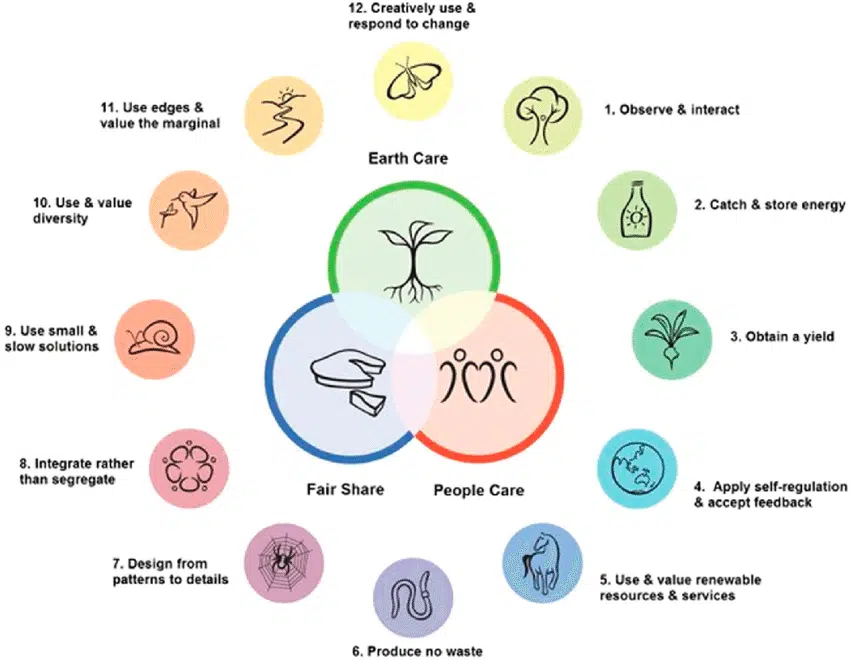Environmental concerns and the importance of sustainable living are now paramount. Permaculture gardening is a powerful way to live in a more sympathetic way with the earth and create gardens that have a positive impact on it, and our future.
In this post, we’re going to dig (pun intended) into this topic and explain what permaculture gardening is, and how you can get started with your own permaculture garden.
What is permaculture?
Permaculture is the development of sustainable and self-sufficient agricultural ecosystems. It’s a philosophy and design system based on using land sustainably, no matter its size. The term is a combination of ‘permanent agriculture’ and ‘permanent culture’, reflecting its basis in ecological farming and its broader relation to various elements of human life.
The phrase was coined in the 1970s at a time when an oil crisis, food insecurity and land-degrading agricultural practices increased a desire in people to be self-sufficient. And today we’re facing similar, ever-more insistent challenges.
The 12 principles of permaculture
Permaculture has 12 principles, which we’ll explain below:
1. Observe & interact
We should take time to carefully observe and understand the patterns and processes of nature before making any interventions. By following the example of natural ecosystems we can design better ways to interact sustainably with the environment.
2. Catch & store energy
We should use, harvest and store energy in its various forms, whether that’s sunlight, rainwater or biomass. This helps us be more efficient and more sustainable.
3. Obtain a yield
We can create systems that provide a yield of food, resources or other outputs, while also benefiting the environment.
4. Apply self-regulation & accept feedback
We need to be open and honest, accept the results of our actions and listen to criticism or feedback.
5. Use & value renewable resources & services
We should use renewable sources and materials that can be replenished over time naturally.
6. Produce no waste
Minimising and utilising waste helps us create closed-loop systems where waste from one element becomes a resource for another.
7. Design from patterns to details
Observing patterns in nature allows us to design systems that are self-sustaining and effective.
8. Integrate rather than segregate
If we integrate different elements the needs of one thing can be met by the other.
9. Use small & slow solutions
Small and slow solutions are often more manageable and sustainable as they can grow and evolve gradually over time, as in nature.
10. Use & value diversity
Incorporating a diverse range of plants, animals and approaches means that if one crop fails, for instance, another may flourish.
11. Use edges & value the marginal
Diverse ecosystems often thrive in marginal spaces, which are rich in biodiversity and natural resources.
12. Creatively use & respond to change
Embrace change and see it as an opportunity for creativity and innovation. Adapting to changing conditions improves the resilience and productivity of systems.
So, what is permaculture gardening?
When it comes to permaculture gardening, we’re talking about using this regenerative and sustainable approach in our own back yards and green spaces, whether we have a large garden or just a couple of window boxes.
Permaculture gardening seeks inspiration from nature, aiming to mimic the efficiency, diversity and resilience of its ecosystems. It encourages us to grow our own food wherever we can, in whatever space we have. From fruit shrubs in pots on your patio to vines on fences and vegetables in planters – permaculture gardening can open your eyes to the potential your space has.
What to consider when creating a permaculture garden
1. Start with a design plan
Create a permaculture design for your garden. Look at the conditions you have, mark your space into zones and map out key elements like planting areas, compost piles and paths.
2. Focus on soil health
Healthy soil is the foundation of a successful permaculture garden, so work on your soil’s fertility and structure by adding compost, mulch and organic matter.
3. Choose appropriate plants
Prioritise native and perennial plants as they’re better suited to local conditions and available resources, and will require less maintenance, while supporting biodiversity.
4. Use water-management techniques
Efficient water management is vital in permaculture gardening. You could use rainwater-harvesting systems, swales and contour planting to use water effectively. Mulching your beds reduces evaporation too.
5. Embrace companion planting
Companion plants support each other by providing pest control, nutrient sharing and shade, helping to create a productive and resilient ecosystem.
Get involved & learn more
To learn more about permaculture gardening, or to get involved in one of our sustainable projects, get in touch today.









